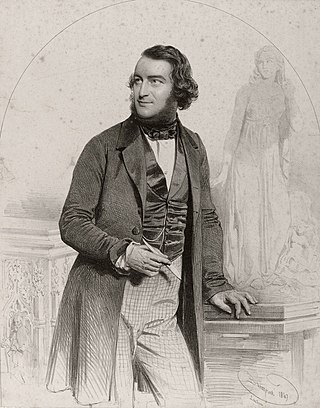Top Qs
Timeline
Chat
Perspective
John Thomas (sculptor)
English sculptor and architect From Wikipedia, the free encyclopedia
Remove ads
John Thomas (1813–1862) was a British sculptor and architect, who worked on Buckingham Palace and the Palace of Westminster.
Life
John Thomas was born in Chalford, Gloucestershire. Apprenticed to a stonemason after being left an orphan, he later went to Birmingham where his elder brother William was an architect (and who later moved to Canada to continue his career). He was noticed by Charles Barry who immediately employed John Thomas as a stone and wood carver on Birmingham Grammar School (now demolished), his first collaboration with Augustus Welby Northmore Pugin. Barry later appointed him the Superintendent of Stone Carving at the Palace of Westminster in London, in which role he was responsible for supplying sixty statues of English kings and queens, including those in the niches of the Central Lobby of the Palace.[1]
Remove ads
Works
Summarize
Perspective


Thomas's work 'Charity' was shown at the Great Exhibition of 1851, and then adapted to form a memorial in Christ Church, Chalford, to his brother Richard who died in 1852. His final work was the colossal statue of William Shakespeare displayed at the 1862 International Exhibition. A dispute over its placement hastened his death in April 1862, and he was buried in Kensal Green Cemetery, London. His massive (30 ft. high and 40 ft (12 m). in diameter) majolica fountain, also on display at the 1862 exhibition, was placed outside the V&A Museum of Childhood until it was demolished in 1926.
Other works
- Twelve large dragons ornamenting ceilings of two grand saloons at Brighton Pavilion, made for the grand re-opening, 1851.[2]
- A replica of the Bristol High Cross, which was erected in 1851.[3]
- Eight allegorical statues at the 1847 Euston railway station representing the cities served by the line: London, Liverpool, Manchester, etc.
- Statue of Hugh Myddelton at Islington Green, London.
- Statue of Godiva, held in Maidstone Museum & Art Gallery
- The Atlas Fountain at Castle Howard
- Four British lions at each corner of the Britannia Bridge crossing the Menai Strait between the island of Anglesey and the mainland of Wales
- extensive friezes and spandrel figures for the Lloyds Bank, Bristol
- Carving and statues on Halifax Town Hall, created c. 1860 – 1862 in collaboration with Edward Middleton Barry to design of Charles Barry. Thomas carved three statues for the tower, but died before completing the fourth, which was overseen by another artist to his design.
- Life-sized plaster maquette (at Canterbury Heritage Museum as of 2013) and bronze (permanently at House of Lords) of Stephen Langton. One of 17 maquettes for 17 bronzes depicting those present at the signing of Magna Carta.
- Boadicea 1855 Y Gaer
- Joseph Sturge memorial, Birmingham (Erected after Thomas' death)
- Tympanum above main door of Leeds Town Hall[4]
Works as an architect
Remove ads
Picture gallery
- Atlas Fountain at Castle Howard
- John Brooks monument, Prestwich church. 1849.
- Rachel daughter of Laban. 1856. V&A Museum London
- Head of Stephen Langton. Part of maquette for a bronze which is now in House of Lords.
- Figure of Athena on Leeds Town Hall
References
Sources
External links
Wikiwand - on
Seamless Wikipedia browsing. On steroids.
Remove ads











